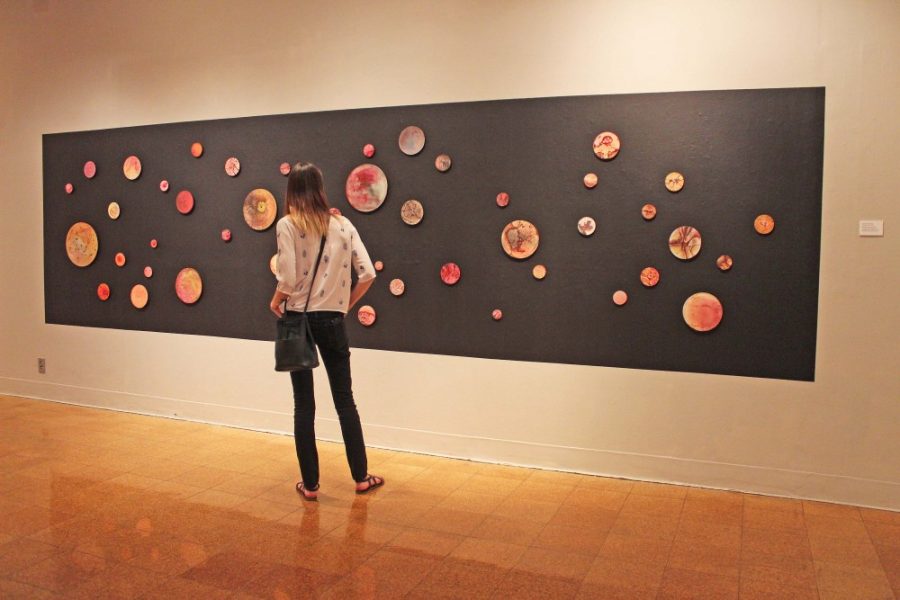Melting glaciers, a vacuum suspended in the air, a faux fast food stand, meticulously hung fabric and other spatial experiences were all part of the UA School of Art’s Master of Fine Arts Thesis Exhibition reception on Thursday, April 20.
Students, artists, faculty and children wandered through the lower level of the UA Museum of Art and the Joseph Gross Gallery, awestruck, confused or intrigued by the installations, which featured 11 different artists’ works in different mediums, ranging from photos to paint to 3-D installations of fabric, ice and metal.
The annual Master of Fine Arts exhibition is held typically during the last semester of a graduate student’s program to finish their Master of Fine Arts Studio degree. Students are required to showcase a body of work to the public as the culmination of their three-year terminal degree program and to receive their Master of Fine Arts degree.
RELATED: Dance ‘Spring Collection’ highlights motions of life
“My husband is the director of the School of Art, and I’ve been to a lot of openings, but this one is great,” said Heather Blakely, a library assistant for Tucson Unified School District. “I love this show and how interactive it is. I love to see what the students are doing.”
Featured artists at the exhibit included: Gladys Garcia, Hellen Gaudence, Janelle Krause, Leah Lewman, Jonathan Marquis, Alissa M. Neal, Erinn Nordeman, Oliver Padilla, Japheth Paul, Elliott Robbins and Shah Noor Shafqat.
Marquis, a 35-year-old graduate student in the School of Art, was behind the “A Geology of the Senses” exhibit, which featured enormous canvases of painted blue hues and shades, a three-dimensional display of melting, material-loaded ice on a solar panel and a digital floor screen of melting ice footage. In these pieces, Marquis, a glacier lover who lived in Missoula, Montana for 12 years, addresses a changing state of nature, the lives of glaciers, as a metaphor for how humanity sensorily operates and interacts with the environment.

“I’m interested in sensory encounters with glaciers and why that shapes us, inspiring ideas about the environment and human-landscape relationships,” Marquis said. “The title of the show being ‘A Geology of the Senses’ addresses the sensory apparatuses as a sort of an incense of geology from the land and the senses as a sort of extraction from the environment. What I want viewers to come away with is a little bit of a reflection on their own sensory being in the world.”
Neal, another graduate student, put on the “A point of Known Return” exhibit, where 1,600 small plastic bags of soil, vegetation and dirt were evenly pinned across a wall for viewers to interact with. Behind each bag, a small tag rested, depicting where its contents were found or what thoughts occurred when its contents were found. To participate with the exhibit, a viewer would take one or more small bags off the wall, place the bag’s content in their hand, walk over to a vacuum suspended in the air and throw their palm into the vacuum tube, releasing the contents to be sucked up and carried outside to a storage drum.
“I wanted to find a new way of documenting my life other than taking photos,” Neal said. “So one day, on New Year’s Day of 2016, I woke up in a weird place and started collecting soil samples, and documented them meticulously. At the end of the year I wanted to take them back and show people what I had done.”
Neal said her aim with her exhibit was to allow others to help her address her obsessive compulsive personality disorder by allowing them to participate in an experience of letting go of possessions. Specifically, the contents she had gathered, marked and placed in plastic bags over a year’s time frame.

“The final iteration of this piece is me kind of letting go of what this dirt had over me and what control I had over the dirt, so I’m asking the viewer to finish this cathartic experience for me by helping release this dirt back out into the wild,” Neal said.
Viewers of Neal’s exhibit were captivated, trying to find the meaning behind all the pinned samples or poetic tags placed with them, as they made their choice of which samples to throw into the vacuum.
“This is an extreme difference from the other side of the gallery,” said Calliandra Hermanson, a 23-year-old UA graduate who majored in anthropology who was deciding to pick a bag. “I think that this piece has something to do with memories and having a sense of place, and trying to keep that with you.”
RELATED: Art professor retires with legacy of creativity
Lewman, 25 and a graduate student in 2D Studio Art, held an exhibit on a large v-shaped wall, painted fluorescent orange on the inside, with pieces of a complete, enormous painting cut into even strips to hang on the fabricated wall. Lewman, in changing the way landscapes were displayed, wanted to have viewers recognize the environment in relation to architectural spaces, and in doing so, rekindle an appreciation of the environment and a desire to experience it with more reflection.

“I’m talking about the visual relationship we have with the landscape when we view it through an architectural window, and how a work of art on a wall can create that same relationship where we are disconnected from what we’re seeing,” Lewman said. “I recognize that in this point in history humanity is so separate from nature, so this whole attempt to connect is kind of disjointed.”
Follow Sarah Covey on Twitter.









